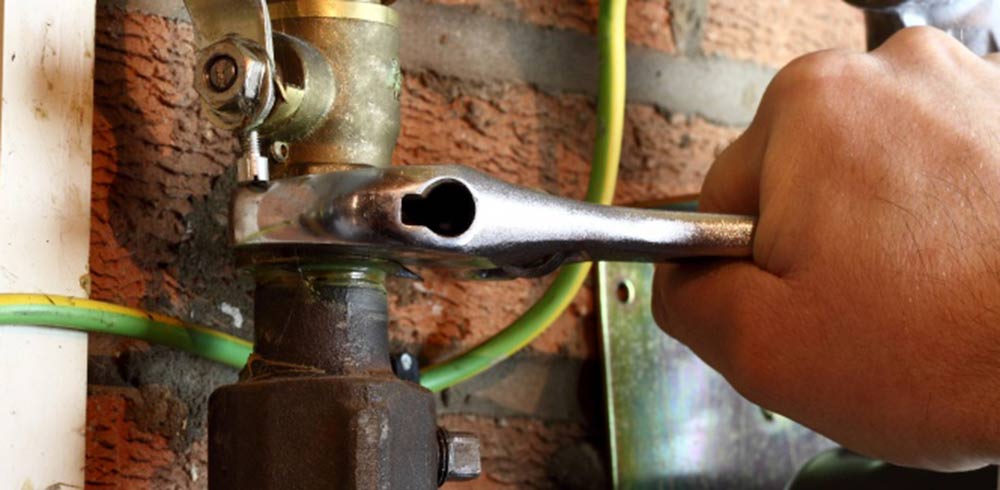
Find the Correct Pipe Thread Size
Pipe threads and fitting sizes refer to the physical dimensions of the fittings but do not necessarily indicate the measurement of the pipe. Within the plumbing industry, the measurement of thread size is referred to as “nominal” pipe thread size, which indicates the inner diameter of the pipe size. This distinction can get confusing as the industry has several different terms that can be thrown around and if you're not sure what to measure and where you can end up with incorrectly sized fittings.
Let's begin by taking a look at a couple of NPT pipe fittings — NPT refers to National Pipe Threads, which is a term defined by ANSI (American National Standards Institute). NPT fittings are the most common threads used for general purposes and feature tapered threads used for joining and sealing the fittings for use with fluids like air or gas.
What are NPT Threads?

Measurement A shows the outside diameter (or OD) of the pipe fitting for a male fitting and Measurement B shows the top diameter of a female fitting. This measurement indicates the actual physical size of the fitting — using this measurement we can then correlate that size with its nominal pipe size (or NPS), which is more widely used. In the chart below you can find the physical measurements of the thread size (Col 1 and Col 2 are the same dimensions) and cross-reference it with the Pipe Thread Size in Col 3. Most often, when we say 1/2-inch in reference to a pipe size or fitting size, it references the nominal size — not the actual diameter shown in Measurement A & B.
US Pipe Thread Sizing Information
| Col 1 (Dimension A) |
Col 2 (Dimension A) |
Col 3 (Dimension B) |
Col 4 |
| OD Fraction Inch |
OD Decimal Inch |
Pipe Thread Size (Nominal Pipe Size) |
Threads per Inch |
| 5/16 | 0.3125 | 1/16 | 27 |
| 13/32 | 0.405 | 1/8 | 27 |
| 35/64 | 0.540 | 1/4 | 18 |
| 43/64 | 0.675 | 3/8 | 18 |
| 27/32 | 0.840 | 1/2 | 14 |
| 1-3/64 | 1.050 | 3/4 | 14 |
| 1-5/16 | 1.315 | 1 | 11-1/2 |
| 1-21/32 | 1.660 | 1-1/4 | 11-1/2 |
| 1-29/32 | 1.900 | 1-1/2 | 11-1/2 |
| 2-3/8 | 2.375 | 2 | 11-1/2 |
| 2-7/8 | 2.875 | 2-1/2 | 8 |
| 3-1/2 | 3.5 | 3 | 8 |
| 4 | 4.0 | 3-1/2 | 8 |
| 4-1/2 | 4.5 | 4 | 8 |
| 5-5/8 | 5.563 | 5 | 8 |
| 6-5/8 | 6.625 | 6 | 8 |
| 8-5/8 | 8.625 | 8 | 8 |
| 10-3/4 | 10.75 | 10 | 8 |
| 12-3/4 | 12.75 | 12 | 8 |

What is Pipe Schedule?
What causes confusion for many people, in or out of the industry, is the thickness of the pipe — which can vary even though the NPS stays the same. Referred to in the industry as Schedule, pipe thickness will indicate how thick the walls of the piping actually are while the inner diameter (or ID) is still the most common distinction for joining two fittings.

What is Threads per Inch or Thread Pitch?
Measurement C shows the length of the threads themselves — when we take a closer look at these threads, we can actually measure the number of peaks and valleys to figure out the number of threads per inch (TPI) or the pitch of the threads. NPT threads have a 60° thread angle, the roots and crests are flat and the taper rate is 1 in 16 inch (which means the pipe size will drop 3/4-inch over 12 inches). To the left is a chart illustrating the most common TPI counts or thread pitch — pitch can be measured using this chart (print to actual size) or by using a thread gauge for more clarity.
Other Pipe Thread Sizing Terms You Should Know
- BSPT (British Standard Pipe Thread): A thread standard primarily used outside the U.S. (e.g., in Europe, Australia, and Asia). Like NPT, BSPT threads taper to form a seal, but the thread angle and pitch differ, making it incompatible with NPT without special adapters.
- FIP or FPT (Female Iron Pipe or Female Pipe Thread): A designation for fittings with internal threads that accept MIP/MPT pipe or fittings. Commonly consists of NPT threads in the U.S.
- MIP or MPT (Male Iron Pipe or Male Pipe Thread): A designation for fittings with external threads that screw into FIP/FPT pipe or fittings. Commonly consists of NPT threads in the U.S.
- Adapter: A fitting used to connect two different types or sizes of pipe threads or pipe materials. It allows transition between thread types (e.g., NPT to BSPT) or between male and female threads.
- Coupling: A short piece of pipe with internal (female) threads on both ends. Used to join two male-threaded pipes of the same size in a straight line or extend pipe length.
- Nipple: A short, straight piece of pipe with external (male) threads on both ends. Used to connect two female-threaded fittings of the same size in a straight line or extend pipe length.
- Union: A three-piece fitting that connects two pipes but allows for easy disconnection and reconnection without turning the pipes themselves. Useful in systems that may need maintenance or partial disassembly.
Remember not to confuse NPS (again, nominal pipe size) with National Pipe Size — which is NOT a real designation. Also, it's important to remember that if you don't feel comfortable measuring your fittings or pipe you should consult a professional — and always remember to make sure all of your projects are up to local codes and standards.
Ready to Buy the Products You Need for Your Project?


